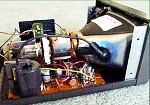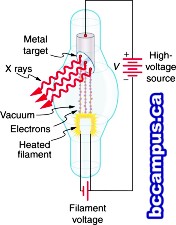TV X-Rays Are Back |
|
See also How the Cathode-Ray Tube Works, Picture Tubes, TV X-Rays, TV X-Rays Are Back, and Whap - You're X-Rayed. TV X-Rays Are Back
The study covered sets from 37 manufacturers, and at least one color receiver of each brand was found to be emitting radiation in excess of the danger level (0.5 milliroentgens an hour at a distance of two inches from the surface of the set). The door-to-door survey was conducted by Seymour Becker, a physicist with the County Public Health Service. Using these figures in an extrapolation, three million of the 15-million color sets now in use in the United States are emitting excessive x-rays. Mr. Becker reports he found 15 separate causes for the excessive radiation, which was being emitted in all directions. Mr. Becker said that all x-ray emissions, even non-harmful ones "technically can be reduced to zero." The amounts of radiation measured varied from 0.5 mR at 5 cm to as much as 150 mR. The average offender emitted 2 to 5 mR. Power supply voltages in the malfunctioning sets ran as high as 40,000 volts with an average of 32,000 to 38,000. Normal high voltage is about 25,000 volts. Editors Note: An excessive high voltage is almost always accompanied by x-ray emission we recommend all technicians to check the high voltage of every color set they service and make any needed repairs. To the set owner we urge that you look at your picture carefully. If it is out of focus or narrow (black edges at the right and left) have your set's high voltage checked immediately. The troubles just described are often produced by excessive high voltage. And excessive high voltage is often accompanied by excessive x-rays. Color and Monochrome (B&W) Television Articles
Posted April 3, 2019 |
|

 Color television was a big hit with homeowners and
was adopted fairly rapidly in the 1960s even considering the relatively high cost and
low number of network color broadcasts in the beginning years. The enthusiasm underwent
a severe reduction when word got out that large doses of
Color television was a big hit with homeowners and
was adopted fairly rapidly in the 1960s even considering the relatively high cost and
low number of network color broadcasts in the beginning years. The enthusiasm underwent
a severe reduction when word got out that large doses of
